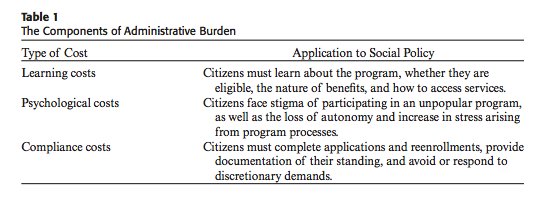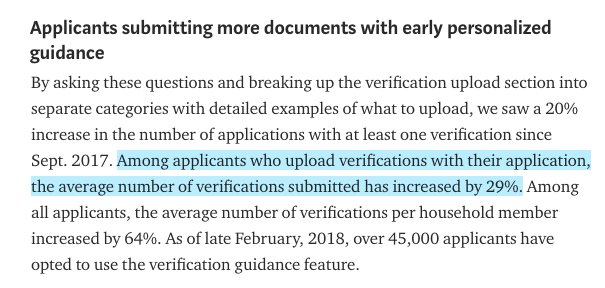"Rationing by friction"
the (sometimes unintentional, sometimes malicious) phenomenon of restricting access to govt services by way of process & paperwork requirements
every friction-laden step prevents some # of people from getting help
breaking down burden into 3 buckets (learning, psychological, and compliance)

To my mind, there are two types of friction:
1. Inherent friction
2. Incidental friction
This is an analogous typology to software complexity: pressupinc.com/blog/2014/05/r…
For example, if we want people to be able to deduct utility costs, and some people use propane, maybe that requires an additional question/language.
Ex: that ppl searching for "food stamps" are overwhelmingly on mobile, but in most states the sites aren't responsive.
Sure there are basics that We Should Just Do.
But the critical value is the measurement of friction.
Sure, adding a new exception that requires a new question on a form will get some outcomes — but some people may then drop off!
How? We moved a critical decision input from a subjective, contestable thing to something we (mostly) can agree on. So we then argue cost vs. benefit.
How does adding alllllll of the "here are the exceptions" language to be on a page and make everyone read it (vs hide it in a dropdown) change conversion?
How does it change *understanding*? (the actual goal)
In general on the tech side, many of these decisions are thrown over the wall to a vendor, and we just pray they know some UX.
For example, we evaluate our document upload tool not by "clients can upload documents from a phone" (a requirements mindset)
but rather by "how many documents do they upload?"
medium.com/code-for-ameri…

we measure features not by "do they do the thing we said it should"
but rather by actual program outcomes (procedural denial rates)
Technology, used effectively for measurement, also means you have a really effective way to measure the costs of complexity in POLICY decisions.
Having different definitions of income for SNAP and Medicaid is a policy decision. That complexity has a cost.
But I do believe one big promise of "digital services" in govt is making that complexity cost—which clients and administrators bare—transparent and known.
(End stream of consciousness)











